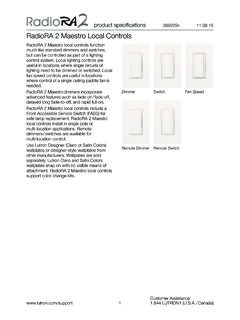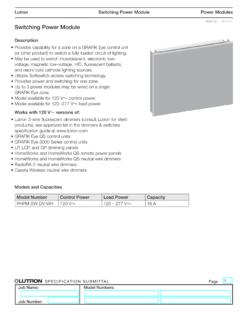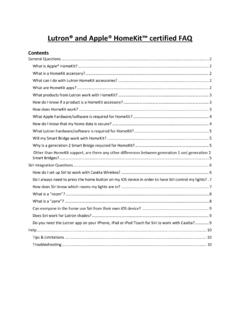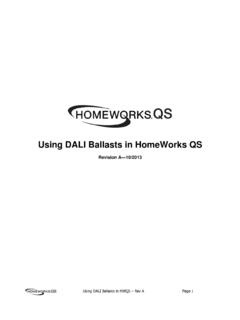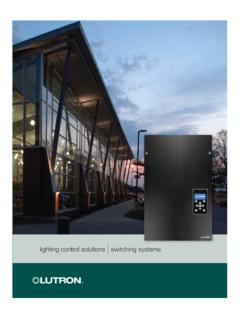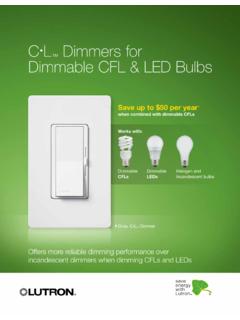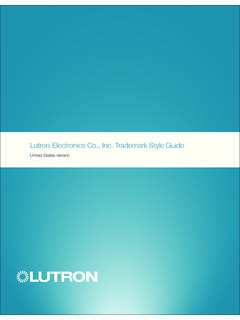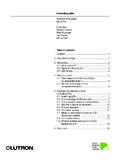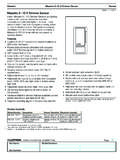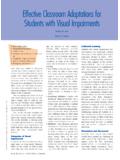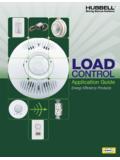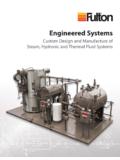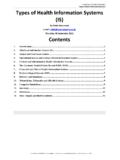Transcription of Code Compliance | Lighting Controls IECC 2012
1 code Compliance | Lighting ControlsIECC 2012 Commercial Application GuideVive SolutionsTable of ContentsIECC 2012 Table of ContentsIECC 2012 This document summarizes the Lighting and receptacle control requirements for commercial buildings. It is for information purposes only. It is not meant to replace your state s or local jurisdiction s official energy code . Please refer to your local building energy code or authority having jurisdiction for your precise requirements. Only the authority having jurisdiction can guarantee code Overview ..2 Summary of code Requirements ..4 Daylight Zone Requirements ..5 Suggested code Compliant Solutions ..6 How to Use this Guide ..8 Vive Local Solutions | Layout ..10 ApplicationsAtriumNew Construction (Dimming 0-10 V) ..12 Break RoomNew Construction (Switching) ..14 Recommended (Dimming 0-10 V) ..16 ClassroomNew Construction (Switching).
2 18 Recommended (Fixture control ) ..20 Conference RoomNew Construction (Switching) ..22 Recommended (Fixture control ) ..24 Egress CorridorNew Construction (Switching) ..26 Recommended (Dimming 0-10 V) ..28 Open OfficeNew Construction (Switching) ..30 Recommended (Fixture control ) ..32 Private OfficeNew Construction (Switching) ..34 Recommended (Dimming 0-10 V) ..36 Restroom (Multi-Stall)New Construction (Switching) ..38 Egress StairwellNew Construction (Fixture control ) ..40 Recommended (Fixture control ) ..4223 Solutions OverviewIECC 2012 StrategyPotential savingsMax: 100%Max: 80%80%High-end trim/tuning sets the maximum light level based on customer requirements in each space. *10 30% LightingAuto OnAuto OffOccupancy/vacancy sensing turns lights on when occupants are in a space and off when they vacate the space.*20 60% LightingFull OnDimDaylight harvesting dims electric lights when daylight is available to light the space.
3 *25 60% LightingFull OnDimPersonal dimming control gives occupants the ability to set the light level.*10 20% LightingShade OpenShade ClosedControllable window shading moves shades to reduce glare and solar heat gain. *10 20% Cooling7am: Dim7pm: OffScheduling provides scheduled changes in light levels based on the time of day.*10 20% LightingFull OnDimDemand response automatically reduces Lighting loads during peak electricity usage times. *30 50% During peak periodAppliance OnAppliance OffPlug load control automatically turns off loads after occupants leave a space.*15 50% of Controlled loadsHeatingCoolingHVAC integration Controls heating, ventilation, and air conditioning systems through a contact closure.*5 15% HVAC* Go to for more informationEnergy-saving Lighting control strategiesCodes can sometimes be complicated and difficult to navigate. This commercial application guide provides examples of how Lutron products can be used to meet or exceed code requirements.
4 This guide focuses on Vive and Vive compatible solutions, but our other control systems offer similar SolutionsPanel SolutionsWallboxViveVive with wireless hub*Energi Savr NodeQuantumStrategies for code /standards complianceOccupancy sensingMulti-level Lighting controlDaylight harvestingReceptacle controlTimeclock **Demand response Energy monitoringBACnet integrationLutron Product Capabilities: Commercial ApplicationsTo learn more about these products and their specifications, go to * For the latest information on products compatible with the Vive wireless hub go to ** Requires QS Timeclock Automated Demand Response capability requires signal from a third-party device45 Summary of Requirements for Lighting and Receptacle ControlsIECC 2012 Daylight Zone RequirementsIECC 2012 Daylight Zone Requirements:Fixtures in primary side-light or skylight zones must be controlled by a daylight sensor in spaces greater than 10,000 sq.
5 Ft. or having greater than 30% window-to-wall ratio. All other daylit spaces only require a separate manual control for daylight Exceptions:Daylight control is not required for daylight zones enclosed by walls or ceiling-height partitions containing two or fewer (HC)SKYLIGHTS ection ViewNOT TO SCALES ection ViewNOT TO SCALEPlan ViewNOT TO SCALE15 ft2 ftPlan ViewNOT TO x HCDAYLIGHT ZONESKYLIGHT ZONESKYLIGHT ZONET oplighting (Skylight)AVERAGECEILINGHEIGHT (HC)SKYLIGHTS ection ViewNOT TO SCALES ection ViewNOT TO SCALEPlan ViewNOT TO SCALE15 ft2 ftPlan ViewNOT TO x HCDAYLIGHT ZONESKYLIGHT ZONESKYLIGHT ZONES idelighting (Window)AVERAGECEILINGHEIGHT (HC)SKYLIGHTS ection ViewNOT TO SCALES ection ViewNOT TO SCALEPlan ViewNOT TO SCALE15 ft2 ftPlan ViewNOT TO x HCDAYLIGHT ZONESKYLIGHT ZONESKYLIGHT ZONEAVERAGECEILINGHEIGHT (HC)SKYLIGHTS ection ViewNOT TO SCALES ection ViewNOT TO SCALEPlan ViewNOT TO SCALE15 ft2 ftPlan ViewNOT TO x HCDAYLIGHT ZONESKYLIGHT ZONESKYLIGHT ZONE For areas being used as a path of egress or fixtures being used for emergency, verify Compliance with your local authority having jurisdiction.
6 Acceptance (functional) testing is required for all new construction applications to ensure that control hardware and software are calibrated, programmed and functioning properly ( code provision ).1 When multi-level Lighting control and/or daylight responsive control is required, Lutron recommends using continuous dimming to allow for smooth light level adjustment and maximize energy Lutron recommends using occupancy sensors to achieve automatic on/off requirements in place of a timeclock to maximize energy savings and optimize user Manual ON is always permitted for interior applications. Provide manual ON control when no automatic ON is control typeDescriptionCode provisionSwitchingLighting shall be capable of turning ON and OFF. There shall be at least one manual device for control of the Lighting within a space. See code for spaces that allow remote location of or dimming1 Lighting shall be capable of being reduced by at least 50% of full power, in addition to being switched ON and OFF.
7 There shall be at least one manual device for control of the Lighting within a space. See code for spaces that allow remote location of & parking garages: Scheduled control , based on time-of-day, turns light-ing ON or OFF based on typical occupancy. Occupancy sensors also comply as an alternate to using a timeclock. Exterior: Scheduled control , based on time-of-day and sunrise/sunset (requires astronomical timeclock), turns Lighting ON or OFF based on typical occupancy and sensorAutomatic control turns Lighting ON upon occupancy or OFF after a vacancy of 30 minutes or less. ONWhen initiated by a timeclock or occupancy sensor, Lighting is automatically turned ON to maximum Lighting ONWhen initiated by a timeclock or occupancy sensor, Lighting is automatically turned ON to 50% or less of maximum Lighting OFFWhen initiated by a timeclock or occupancy sensor, Lighting is automatically turned OFFWhen initiated by a timeclock or occupancy sensor, Lighting is automatically reduced by at least 50% of maximum Lighting power.
8 In some spaces, partial OFF is permitted but it is not a code Daylight responsive control1 Interior: Manual or automatic control of sidelight and skylight daylight zones is required. When using automatic control , there must be at least two levels between ON and OFF. See the Daylight Zone Requirements for more : A photosensor can be used as an alternate to the dawn/dusk operation of an astronomical ControlAutomatic Control3 OtherThe requirements listed below are summarized for simplicity and may have other exceptions that were RoomClassroom, Lecture Hall, Training RoomConference, Multi-purpose RoomEgress Corridor4 Lobby SwitchingMulti-level or dimmingTimeclockOccupancy sensorFull ONPartial ONFull OFFP artial OFF Daylight responsive controlSuggested code Compliant SolutionsIECC 2012 Suggested code Compliant SolutionsIECC 2012 The compliant solutions listed below are suggested based on total installed cost, simplicity of design, and basic functional needs for the space.
9 These solutions do not represent the only compliant options to meet Lighting and receptacle control requirements. Applications in this guide will illustrate these solutions and/or alternative solutions for advanced functionality. ASHRAE 2010 can also be used as a Compliance option in meeting IECC 2012 key: = New construction = Lighting retrofit1 = New construction and retrofit11 All retrofits altering more than 50% of the luminaires, or 10% with alterations to Controls and/or circuits, must comply with all new construction Manual ON is always permitted for interior applications. Provide manual ON control when no automatic ON is Not a code requirement. Lutron recommends this solution for spaces designated as a path of For areas not designated as a path of egress, the occupancy sensor must turn lights to full Timeclock ensures the lights are on when typically occupied.
10 Occupany sensor Controls lights when typically Office (>300 sq. ft.) Private Office (<300 sq. ft)RestroomEgress Stairwell4 Storage RoomFacade/ LandscapeParking Garage(Not Roof)5 Other ExteriorLocal ControlAutomatic Control2 Other3389 How to Use this GuideIECC 20121819 Classroom | New ConstructionIECC 2012 Classroom | New ConstructionIECC 2012 Visible System ComponentsControl FunctionalityOccupant Enters:Lights do not automatically turn on when an occupant enters the space; lights must be turned on Occupied:Manual: Occupant uses wall switches to turn on and turn off general, white-board Lighting , and perimeter daylight Exits:All lights automatically turn off 15 minutes after all occupants a Vive wireless hub to enable simple setup and re-zoning, system monitoring, timeclock functionality, and advanced NumberDescriptionQtyList Price EachRMJS-16R-DV-BPowPak switching module3$ Powr Savr wireless corner-mount vacancy sensor1$ wireless 2-button control3$ wallbox adapter3$ Energy Savings*45%* Go to for more wiringClear ConnectRF Communication33333322211112 Radio Powr Savr wireless corner-mount vacancy sensorPico wireless control33 Pico wireless controlCode Notes: For non-daylight classrooms, all general Lighting can be connected to a single switching module.
